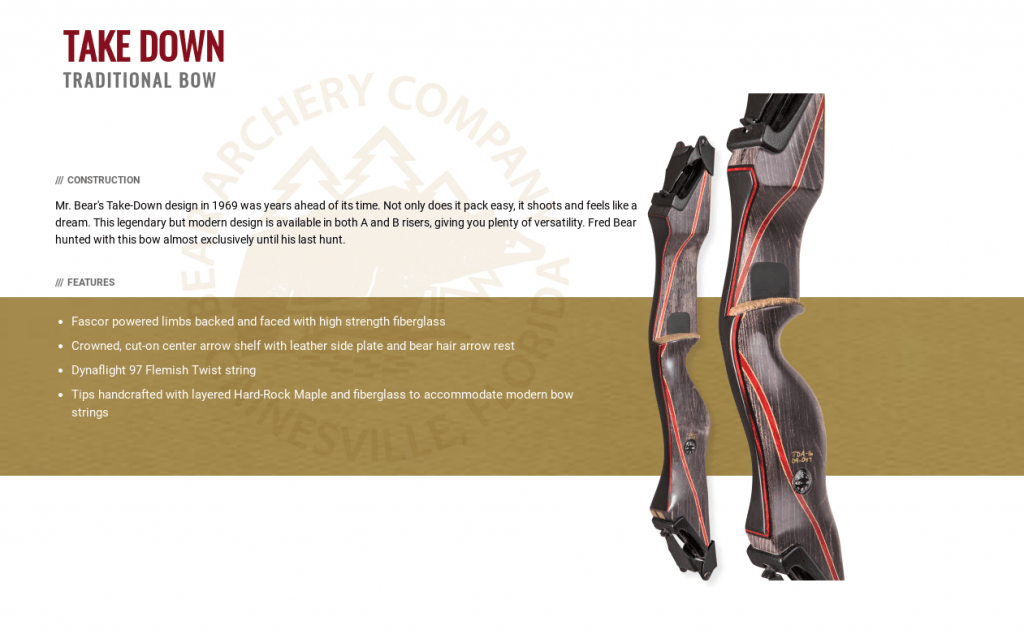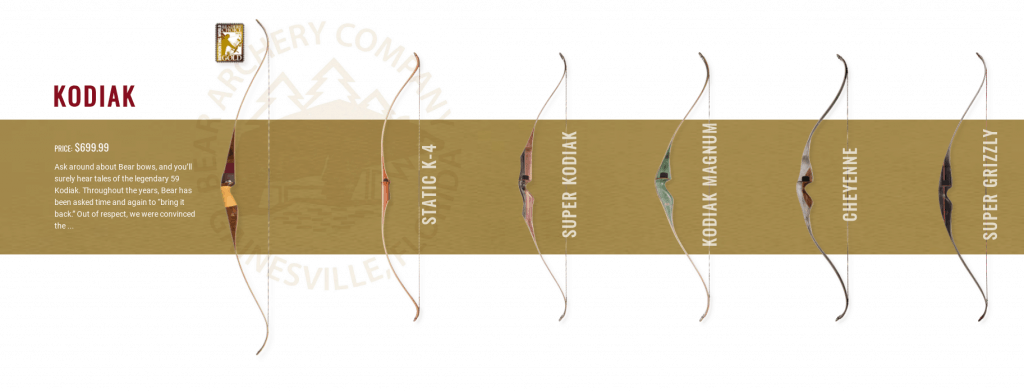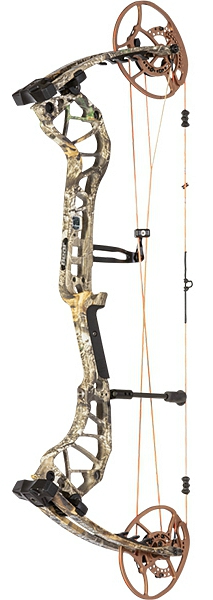There is a lot of gear involved in the sport of archery, but none are more important than the bow itself. That importance can translate into a lot of anxiety when it comes time to buy your first bow or even a new bow.
Even a small amount of research is bound to have turned up the brands Bear and Diamond. If you’re going back and forth between the two, this article will help you split the difference and choose the bow that’s right for you.

Most History: Bear Archery
Now, I know we’re talking about the bows specifically, but a company’s history has a lot to do with how they manufacture their products, especially in the archery community.
And when it comes to a long history of bow making, Diamond just can’t compete with Bear.
Bear’s Origins
Bear is one of the oldest archery companies in the game.
Its founder, Fred Bear, was a highly-respected and talented archer who loved the sport so much that he helped produce hunting videos of himself as well as making archery gear for his family and friends on the side.
By 1939, his reputation for making bows, arrows, and other equipment grew too large for him to maintain by himself, and he started Bear Archery Company.
Since that time 80 years ago, the company has grown exponentially; however, the quality of the products has not appeared to have suffered at all during the expansion.
Today, Bear Archery’s bows incorporate modern technology while also keeping their humble, detail-oriented roots at the forefront of their business model.
Diamond’s Origins
Diamond does not boast such a storied past, but that isn’t necessarily a bad thing.
What many archers may not realize is that Diamond is owned by Bowtech, another prominent bow manufacturer in the market.
But before they were affiliated with Bowtech, Diamond Archery got its humble start in 1996 when two passionate archers, Josh Halbert and Gary Green, put their heads together to create the company.
The brand did relatively well on its own, but when the opportunity came to join Bowtech’s family in 2004, Diamond took it.
As it happens, Bowtech is an even younger company than Diamond, making its debut in 1999 when another two archers, John Strasheim and Kevin Strother, decided to put their knowledge to better use.
Clearly, the merger didn’t detract anything from Diamond and actually allowed them to grow in ways that they probably couldn’t have on their own.
If a break from tradition doesn’t bother you, you might appreciate the fresh perspective that Diamond Archery brings to bow design.
Best Innovations: Bear Archery

Determining a winner for this category was difficult because Diamond’s parent company, Bowtech, has contributed a significant innovation to the world of archery and to compound bows in particular.
However, I think it’s only fair to try Diamond Archery as its own company.
And on its own, Diamond just can’t compete with the creative approach that Bear has used when designing their bows.
To be fair, they did have quite a few more years to develop these innovations, but the fact remains that their impact on the archery community has stood the test of time.
Perhaps the most important discovery Bear has made is the takedown recurve.
The technology is so popular now that one may not even be aware that Bear was the company that made it possible.
And it may seem like a simple adjustment to make the limbs of a bow removable from the riser, but the extreme improvement on convenience was revolutionary in a time when everyone was used to carrying around a large bow that was unable to be made more compact for travel.
However, if you’re more into compound archery, Bowtech’s innovation (which appears on all Diamond bows) will be of more importance to you.
In Bowtech’s case, their innovation capitalized not on convenience but on power and precision.
That enhancement came in the form of a binary cam system.
Binary cams made perfect synchronization between the two devices possible, something that the former hybrid, twin, and single cams just weren’t doing.
Nowadays, binary cams are almost universally preferred over the other cam systems, as are takedown recurves over traditional, one-piece recurves.
Best Price Range: Bear Archery
Diamond Archery is typically known as the bargain brand-at least, it’s the bargain version of Bowtech.
However, Bear’s massive selection actually consists of more value bows while also offering high-end luxury bows for top dollar.
For example, Bear’s most expensive bow for 2019 is the Perception, which is part of their Legend Series.
This bow goes for just under $1,500, which is certainly on the higher end of the price spectrum for bows.
For a serious archery professional who’s looking to upgrade their setup, however, this is going to be a much more attractive option than Diamond’s most expensive bow, the Deploy SB w/ RAK or the Carbon Knockout.
Diamond’s high-end options are about $800 less than Bear’s, and they come with significantly lower speeds, making them more middle-of-the-road than high end.
You would think that with bows like the Perception, Bear would not have very many low-budget options, but they do.
In fact, they have seven bows selling for less than $400, while Diamond only has three.
Nothing against Diamond Archery, but for being the “bargain” brand, it appears that they don’t have very many bargains.
If you’re looking for a medium-priced bow for a beginner to an amateur archer, Diamond should work just fine.
Otherwise, Bear is going to have more options for a better variety of prices.
Best Variety: Bear Archery

Speaking of variety, Bear dominates this category in general as well.
I’m talking the number of bows, types of bows, bows for all ages, etc.
Again, it may be that as Diamond gets older and expands, they will have the time and resources to devote to other types of archery as Bear has done.
But as of now, Diamond is solely devoted to compound bows for target shooters and hunters, and mostly adults at that.
Their inventory for this year totals just ten bows to choose from, while Bear is offering more than 40, and that isn’t including their selection of crossbows.
Again, it’s entirely possible that you’re just one adult archer interested in not much more than target shooting and/or bowhunting with a compound bow, in which case you’ll probably be able to find something from Diamond that works for you.
But even if you are that person, you’re going to have a wider selection of target bows and hunting bows at Bear.
And if you’re an archer who has a young family and/or who has interests ranging outside of compound bows and traditional archery activities, Bear Archery is the only one of the two companies that is going to be able to cater to your other needs.
Fastest Bow: Bear Archery
Bear Archery also has Diamond Archery beat when it comes to speed.
Compound bows are popular in the western part of the world largely for their speed and power, which typically outmatch any recurve or longbow on the market.
And if top speed is important to you, Bear is once again the most equipped company to fill your request.

Granted, Diamond still has some pretty fast bows.
Their most expensive bow also happens to be the fastest-once again, it’s the Deploy SB.
The Deploy, when fired at a draw length of at least 30 inches, can hit 330 feet per second, which is no laughing matter.
So, if you’re simply looking for a pretty fast bow, Diamond can accommodate.
But the real speed-chasers are not going to be satisfied with that.
Not many compound bows can go faster than 350 feet per second, which makes Bear Archery’s Perception bow one of the fastest you can get.
At 350 feet per second, you can definitely attain your goals of taking down that prized buck or successfully shooting across longer distances than you ever have before.
Lightest: Bear Archery
Especially for bowhunters, weight is a huge deal when deciding between bow models.
No one wants to lug a heavy piece of equipment through the forest or across the plains for a full day, and they really don’t want to have to hold it up for minutes on end while they wait for their target to finally clear the trees.
Diamond Archery has some pretty good options for low-weight bows, and they go as low as 3.2 pounds if you get the Carbon Knockout compound bow.
They also have the Atomic bow that weighs a meager 1.7 pounds, but that’s because it’s a children’s bow, so we won’t count it here.
If you’re like me, you’ll have thought that adult bows just can’t get much lighter than 3.2 pounds.
But that’s where Bear comes in and wows the crowd even further.
Their Cruzer model, which can be used by both children and adults, goes under the three-pound mark, weighing in at just 3 pounds.
That’s lighter than some pineapples!
This means that your bow could potentially weigh less than your lunch, a huge plus if you’re carrying all your own gear on your hunting trip.
Most Awards: Bear Archery
When the new bows come out every year, archery fanatics are quick to give all the new models a test, and everyone has an official ranking that they put out.
When looking for a new bow, it can be helpful to turn to the opinions of those who handled a lot of bows in their time, especially new bows.
And the experts’ verdict is pretty clear: Bear Archery consistently makes better bows.
This isn’t to say that Diamond Archery doesn’t win awards for their bows.
Their Infinite and Edge 320 have certainly been talked about by a lot of bow connoisseurs and are pretty popular pieces of equipment.
However, they just don’t usually appear in the top ten rankings of most bow authorities like Bear does.
Unsurprisingly, Bear’s top competitors seem to be the Perception and the Divergent models.
Best Design: Tie
Honestly, I’m no expert on bow design. When it comes to aesthetics, it takes a lot to stand out from the crowd.
Additionally, this category is so subjective that it’s nearly impossible to find a bow that is universally recognized as the most overall attractive bow.
Some people prefer a minimalist, sleek profile while others have a proclivity for bulky, tough-looking bows decked out with accessories.

After all, beauty is in the eye of the beholder.
Though there are obviously those who find themselves in between these two poles, I’ll suggest a sleek option and bulky option from both Bear and Diamond to at least set the spectrum straight.
First, sleek bows.
This is my personal preference in a bow’s look, and if I were to choose a brand new bow from Bear Archery’s selection, I would go with either the Divergent, the Revival, or the Approach HC.
I would say that the Diamond equivalents of these chis masterpieces are the Prism and the Medalist 38.
On the bulkier end of the spectrum, Diamond delivers with the Edge SB-1 and the Edge 320.
None of Bear’s bows are particularly bulky, but they do have the Threat model that tends to be on the heftier side.
Best Community: Tie
When you buy a bow, you’re not just buying a bow.
You’re really joining a family. The archery community is very tight-knit, and the communities that pop up around certain brands are even tighter.
So, community is really something you have to consider when choosing a brand to side with.
Neither Bear or Diamond are really heavy on their community-building, at least not like PSE or some of the other bow brands out there.
Of course, anywhere you go, you’ll likely find a fan club of any brand, and there are blogs and social media groups that you can join for both Bear and Diamond.
So, if communication and connection with fellow archers is what you’re looking for, you’ll likely have to seek it out yourself with either Bear or Diamond.
Best Customer Service/Warranty: Bear
Once again, I suspect that Bear has won this category as a result of being in business for so many years.
The reputation of Bear’s customer service representatives are generally good, and a lot of Bear customers have good things to say about their experience with Bear employees.
Diamond just hasn’t earned that reputation yet.
Customer service is one of the primary areas where companies feel growing pains, no matter the business they’re in.
Additionally, Bear’s warranties are just so much better than Diamond’s.
Any bow purchased from Bear has a lifetime warranty on both risers and cams, while limbs are covered 100% at no charge for the first five years and 50% after that.
Comparatively, Diamond only offers warranties on bows not sold over the internet.
Granted, the warranties are lifetime warranties, but with a lot of exceptions and subtext.
Plus, how many people are going to take the time to drive to an authorized dealer when nearly all of Diamond’s bows are available on Amazon?
Maybe the warranty wouldn’t be such a big issue if the customer service reps were as kind as Bear’s.
Best Accessories: Bear
Finally, we come to accessories.
This isn’t normally what people think about when they are trying to pick the best bow, but if you’re like me, then you enjoy it when you can get all the gear you need from one place.
It doesn’t take much for Bear to win this one, as Diamond doesn’t technically have any accessories and even Bowtech (their parent company) doesn’t have more than seven.
If you go with a Bear bow, you can pick up almost any accessory you need in the same stop, which says a lot about how much they think about their customers.
Ultimately, the choice is yours.
What I view as strengths you may view as weaknesses and vice versa.
Just because Bear won the majority of the categories examined in this article doesn’t mean that a Diamond bow isn’t right for you.







